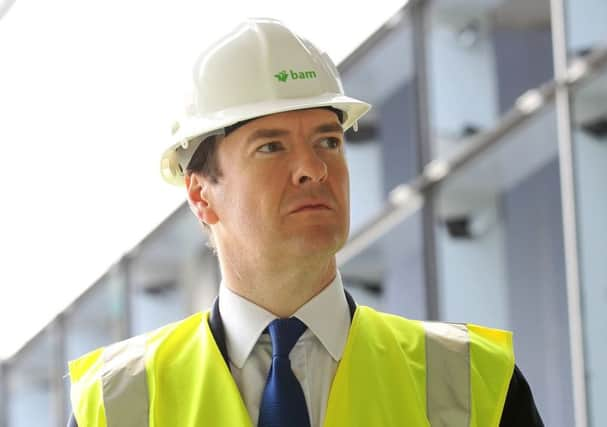Choice for those nearing pension age


It’ll be a year before the biggest pension reforms unveiled in the recent Budget become reality – but some of wide-ranging changes set out by the Chancellor have already come into force.
Financial advisers in Scotland have reported significant interest among pension savers in new rules giving them greater flexibility when deciding what to do with their retirement pot.
Advertisement
Hide AdAdvertisement
Hide AdHowever the measures, which took effect on Thursday, have created a fresh dilemma for many savers nearing retirement.
While most people in defined contribution (DC) schemes use their savings to buy an annuity at retirement, in order to secure a regular income, a small proportion go for drawdown.
This is where the pension pot remains invested and income is taken from it in tranches, subject to restrictions.
The two forms of drawdown are flexible, where investors with a certain amount of income can take as much as they like from their pension, and capped, where there’s a limit on the amount that can be taken each year.
But the restrictions on those options were eased in the Budget presented by George Osborne, pictured below right, last week.
The minimum guaranteed income required for savers to use flexible drawdown was reduced from £20,000 to £12,000, while the maximum income that can be taken from a pension through capped drawdown has risen from 120 to 150 per cent of an equivalent annuity (although some insurers don’t yet offer the new limits).
It was only a year ago that the maximum was restored to 120 per cent after the government had cut it to 100 per cent in 2011 in fear of pensioners using up their savings too quickly.
With annuities currently offering poor value, the new rules have been enthusiastically received by investors approaching retirement.
Advertisement
Hide AdAdvertisement
Hide Ad“This will be good for people who are knowledgeable about investments and can take advantage of getting the cash out of the pension,” said Derek Stewart, managing partner at Sam Wealth in Glasgow. “It will also mean that assets can pass on to the next generation, which didn’t happen with annuities.”
But drawdown is not for everyone, warned Alan Dick, principal at Forty Two Wealth Management. “Many people greatly underestimate how hard an investment portfolio has to work to provide a greater return than an annuity,” he said. “Many also greatly underestimate their life expectancy. However, for the right people, drawdown is a fantastic option – the flexibility of income and death benefits definitely suit some people.”
So how do you know if drawdown is right for you?
Even under the new rules, the emphasis is on having other assets and income sources to fall back on in the event of poor investment performance.
“Previously the regulator would have raised eyebrows if someone entered a drawdown contract with less than £100,000 and didn’t have substantial other assets,” Stewart pointed out.
If you’re in capped drawdown there’s a risk that by taking advantage of the new 150 per cent income level your fund will erode more rapidly unless steps are taken to increase the rate at which it grows.
“Allowing people to draw 150 per cent will mean that many people will end up significantly eroding their pension pots long before the end of their lives,” said Dick. “I worry that emotion will overcome common sense in some cases.”
There are considerable investment implications to think about for anyone previously intending to buy an annuity but now leaning towards drawdown.
Many people have their money in “lifestyle” strategies, where their money moves into lower risk assets as retirement approaches.
Advertisement
Hide AdAdvertisement
Hide AdBut this strategy is designed for annuity purchase and is unlikely to be a viable investment approach for drawdown, said Dick.
“A long-term strategy which has to cover the costs of drawdown and ongoing advice, and still keep pace with increases in the cost of living, needs to have a reasonably significant exposure to equity risk,” he explained.
Most existing retirees will have to wait before taking advantage of the higher income rate, with drawdown reviews typically held every three years (annually over age 75), although they can ask for an emergency review on the anniversary of entering drawdown.
But if you’re not comfortable with keeping your pension savings invested, or you don’t have other income or assets to fall back on, an annuity remains the best bet.
“Annuities still have a part to play for those who are cautious,” said Stewart. “It may be that they hedge their bets and take some as cash that would otherwise have bought the annuity and invest it, or spend it.”
Cash option now available for thousands more savers
Thousands of people reaching retirement with modest pension pots are now able to cash them in rather than be forced to buy an annuity, under Budget changes that took effect on Thursday.
Small pension pots could previously be cashed in only if they had a combined value below £18,000, under trivial commutation guidelines. Stand-alone occupational pensions below £2,000 could also be cashed in, while over 60s had the same right with non-occupational pensions valued at no more than £2,000.
The limit on trivial commutation has now risen to £30,000 and up to three pension pots worth £10,000 or less can be taken as cash, up from two worth no more than £2,000, regardless of the individual’s wealth.
Advertisement
Hide AdAdvertisement
Hide AdThe changes apply to those aged 60 or over. A quarter of the lump sum can be taken as tax-free cash and the remainder is taxed at the saver’s marginal rate.
And with two thirds of annuities sold for pensions worth £30,000 or less, including three in ten annuities bought with pensions below £10,000, Thursday’s changes